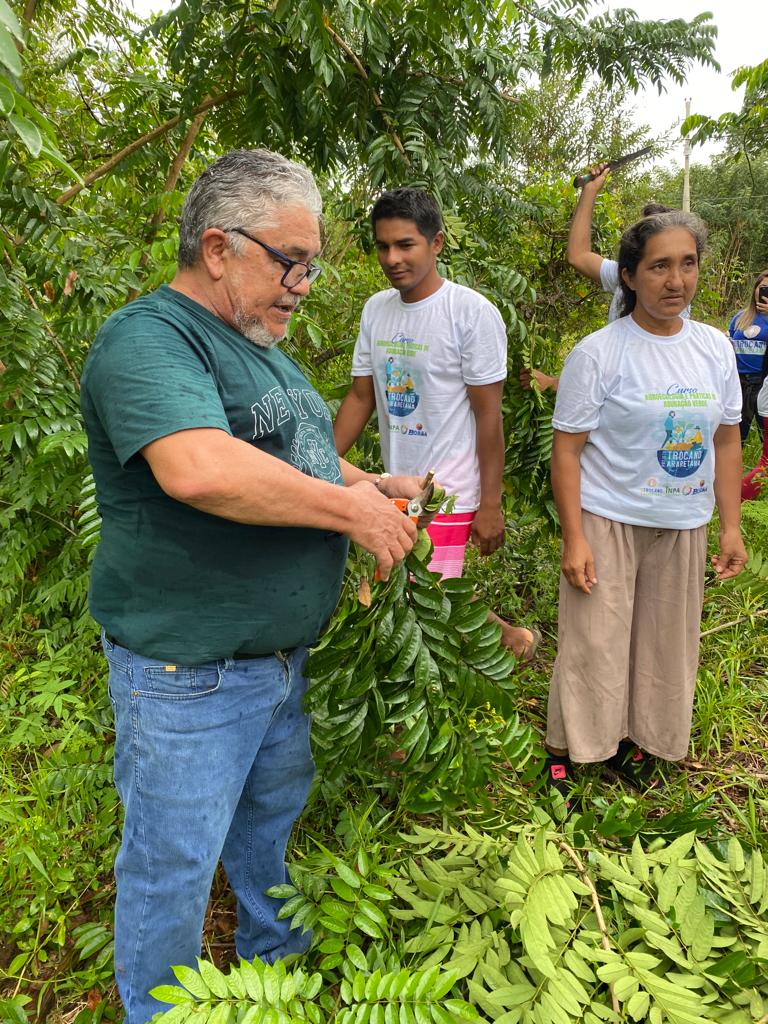Local farmers learn the benefits of green manuring.
An agroecology and green manuring course was held in the Trocano project from the 8th to 10th May 2023. The course was held for the communities in the Axinim District in Borba. Axinim is located approximately 50km from the seat of the municipality.
The design of the course was to educate the local community in the practices of agroecology and green fertilization. It focused on the importance of ecosystems and how an ecological approach can be applied to farming practices.
Implementation of the course was jointly initiated by the Trocano Project team and the National Institute of Amazonian Research-INPA. INPA researcher Professor Luiz Augusto Souza led the teaching.
Thirty students from the local communities, attended the course which included both theory and practical elements. All students received the educational materials needed to complete the course.

What is Agroecology?
Agroecology is an integrated approach that applies ecological and social concepts and principles to the design and management of sustainable agriculture and food systems. Agroecology promotes farming practices that are beneficial in 3 ways:
- That mitigate climate change, especially reducing emissions, recycling resources and prioritising local supply chains.
- That work with ecosystems, managing the impact of farming on wildlife. Also harnessing nature to help, such as pollinating crops and controlling pests.
- That empowering farmers and communities.
These approaches are led by local people. Its purpose is to adapt agricultural techniques to suit the local area, and its specific social, environmental and economic conditions.
Importance of ecosystems in agroecology
The class began with explaining the importance of the ecosystem and its sources of energy. It also covered the benefits and primary sources of power and the importance for the ecosystems.
Students learned about the advantages of all the existing resources for the maintenance of this ecosystem. They also learned about avoiding as much as possible to leave the soil exposed, always keeping creeping plants as ground cover. This prevents the soil from becoming compacted and avoiding the loss of minerals.
Reusing organic waste is an incentive for the community not to use fire for cleaning. This gives a second option for it to be used effectively in their crops.
Permaculture is an important part of Agroecology
The students also learned about permaculture. This is a system in which each activity benefits from the other, intended to be sustainable and self-sufficient. This system is an excellent option for the farmers. It is a cycle that will serve to fertilize the crop and the crop will serve as feed for the animals. Subsequently, the surplus will then serve as income for the farmer.
The participating farmers were very excited and began to share experiences and ask questions. They endeavored to absorb as much knowledge as possible to apply in their daily lives on the site.
Other topics covered in the course included identifying appropriate species and collecting and processing fruits for the collection of seeds.
Another element of the course was the construction of seedling nurseries, using resources that were readily available, such as straw, vines and wood. Various techniques of using material that is found within the communities were discussed. The farmers were excited because they felt able to build their nursery in a profitable way that did not affect their financial life.
Green manure practices
INPA Professor Luiz Augusto addressed green manure techniques. He spoke about the importance of some species that there are in the community itself that can serve as fertilizer. This technique uses the species of legumes, which are rich in nitrogen. They can provide a large number of nutrients to the plants.
The technique of green manure is carried out with leguminous species cut or freshly crushed, and incorporated into the soil. The entire process needs leaves of fresh legumes. This is to be able to provide with greater effectiveness the nutrients present in the leaves for the fertilized plants.
This part of the course involved some practical work. This training is to enable the farmers in the identification of the species and to be able to use them as green manure in their cultivation.
INPA Professor presents his green manure research
Professor Augusto presented his research at INPA to demonstrate the effectiveness of applying green manure practices. His study involved five different plots, and a control area. The results of the study were very positive. It concluded that green manure using legumes is effective due to the high concentration of nitrogen present in the leaves. Even the soil of floodplains being naturally rich in nutrients, could not overcome the results of legumes.
Valuable knowledge for farmers and their communities
The course was extremely valuable to the local farmers and their communities. It presents new mechanisms for fertilization and sources of alternative materials present in their communities at low cost. It also introduced the ideas of obtaining alternatives to improve their activities in the crop.
All participants received certificates for completing the course. The two-day course closed following the students thanking the partner organisations for bringing the art of agroecology and green manuring to them.






